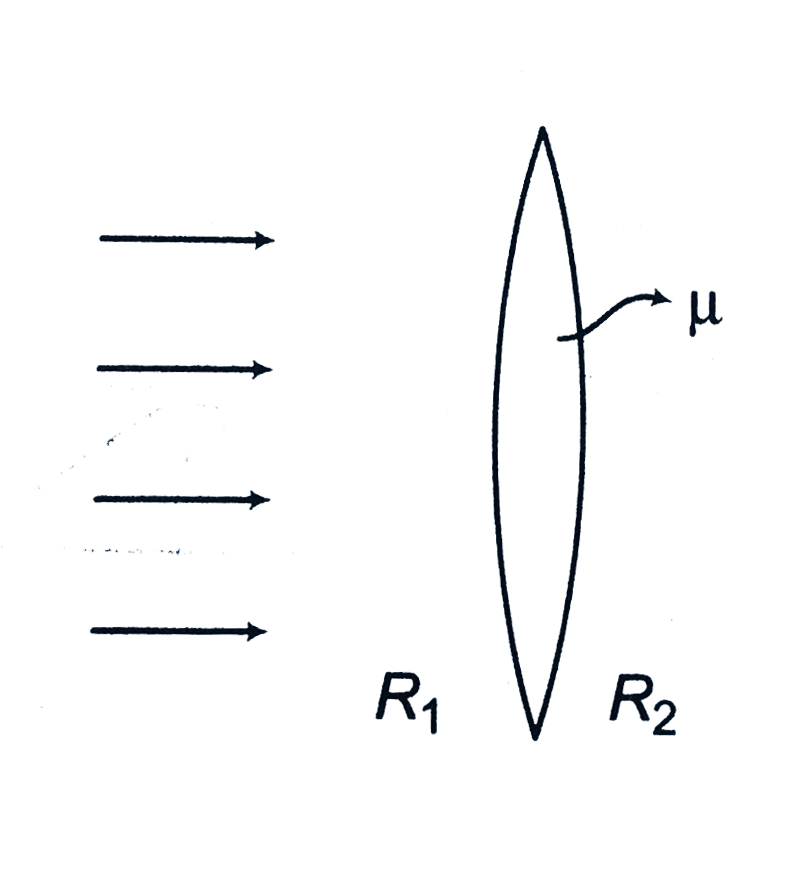A biconvex lens of radii of curvature 20 cm has refractive index 1.56 for blue colour and 1.48 for red colour. The approximate linear spread of focus for white light is
3.6 cm
4.2 cm
3.0 cm
5.0 cm
The correct Answer is:C
To solve the problem of finding the approximate linear spread of focus for white light through a biconvex lens with given parameters, we can follow these steps:
1. Identify the Given Values:
- Radius of curvature (R) = 20 cm
- Refractive index for blue light (μ_B) = 1.56
- Refractive index for red light (μ_R) = 1.48
2. Use the Lensmaker's Formula:
The focal length (f) of a biconvex lens can be calculated using the formula:
1f=(μ−1)⋅2R
Rearranging gives:
f=R2(μ−1)
3. Calculate the Focal Length for Red Light:
Substitute μ_R into the formula:
fR=202(1.48−1)=202⋅0.48=200.96≈20.83 cm
4. Calculate the Focal Length for Blue Light:
Substitute μ_B into the formula:
fB=202(1.56−1)=202⋅0.56=201.12≈17.86 cm
5. Calculate the Difference in Focal Lengths:
The linear spread of the focus for white light is given by the difference in focal lengths:
Δf=fR−fB=20.83−17.86≈2.97 cm
6. Approximate the Linear Spread:
Rounding off the result gives us:
Δf≈3 cm
Final Answer:
The approximate linear spread of focus for white light is 3 cm.
---
- Radius of curvature (R) = 20 cm
- Refractive index for blue light (μ_B) = 1.56
- Refractive index for red light (μ_R) = 1.48
The focal length (f) of a biconvex lens can be calculated using the formula:
1f=(μ−1)⋅2R
Rearranging gives:
f=R2(μ−1)
Substitute μ_R into the formula:
fR=202(1.48−1)=202⋅0.48=200.96≈20.83 cm
Substitute μ_B into the formula:
fB=202(1.56−1)=202⋅0.56=201.12≈17.86 cm
The linear spread of the focus for white light is given by the difference in focal lengths:
Δf=fR−fB=20.83−17.86≈2.97 cm
Rounding off the result gives us:
Δf≈3 cm
The approximate linear spread of focus for white light is 3 cm.
Similar Questions
A plano convex lens of radius of curvature 30 cm and refractive index 1.5 is kept in air. Find its focal length (in cm).
View SolutionA biconvex lens with equal radii curvature has refractive index 1.6 and focal length 10 cm. Its radius of curvature will be:
View SolutionA biconvex lens (μ=1.5) has radius of curvature 20cm (both).
find its focal length.

View SolutionA diverging meniscus lens of radii of curvatures 25 cm and 50 cm has a refractive index 1.5. Its focal length is (in cm)
View SolutionA bicovex lens has radii of cuvature 20 cm each. If the refractive index of the material of the lens is 1.5, what is its focal length?
View SolutionA double convex lens has two surfaces of equal radii R and refractive index m=1.5, we have
View SolutionThe power in dioptre of an equi-convex lens with radii of curvature of 10cm and refractive index 1.6 is
View SolutionA biconvex lens has radii of curvature 20 cm and 40cm. The refractive index of the material of the lens is 1.5. An object is placed 40cm in front of the lens. Calculate the psition of the image.
View SolutionThe two surfaces of a biconvex lens has same radii of curvatures . This lens is made of glass of refractive index 1.5 and has a focal length of 10 cm in air. The lens is cut into two equal halves along a plane perpendicular to its principal axis to yield two plane - convex lenses. The two pieces are glued such that the convex surfaces touch each other. If this combination lens is immersed in water (refractive index =43 ), its focal length (in cm ) is
View SolutionA biconvex lens of focal length 20cm, made of glass or refractive index 1.5, has water (μ=1.33) on one side and air on the other. An object is placed 15 cm form the lens on the side with water. Where is the image formed?
View Solution
